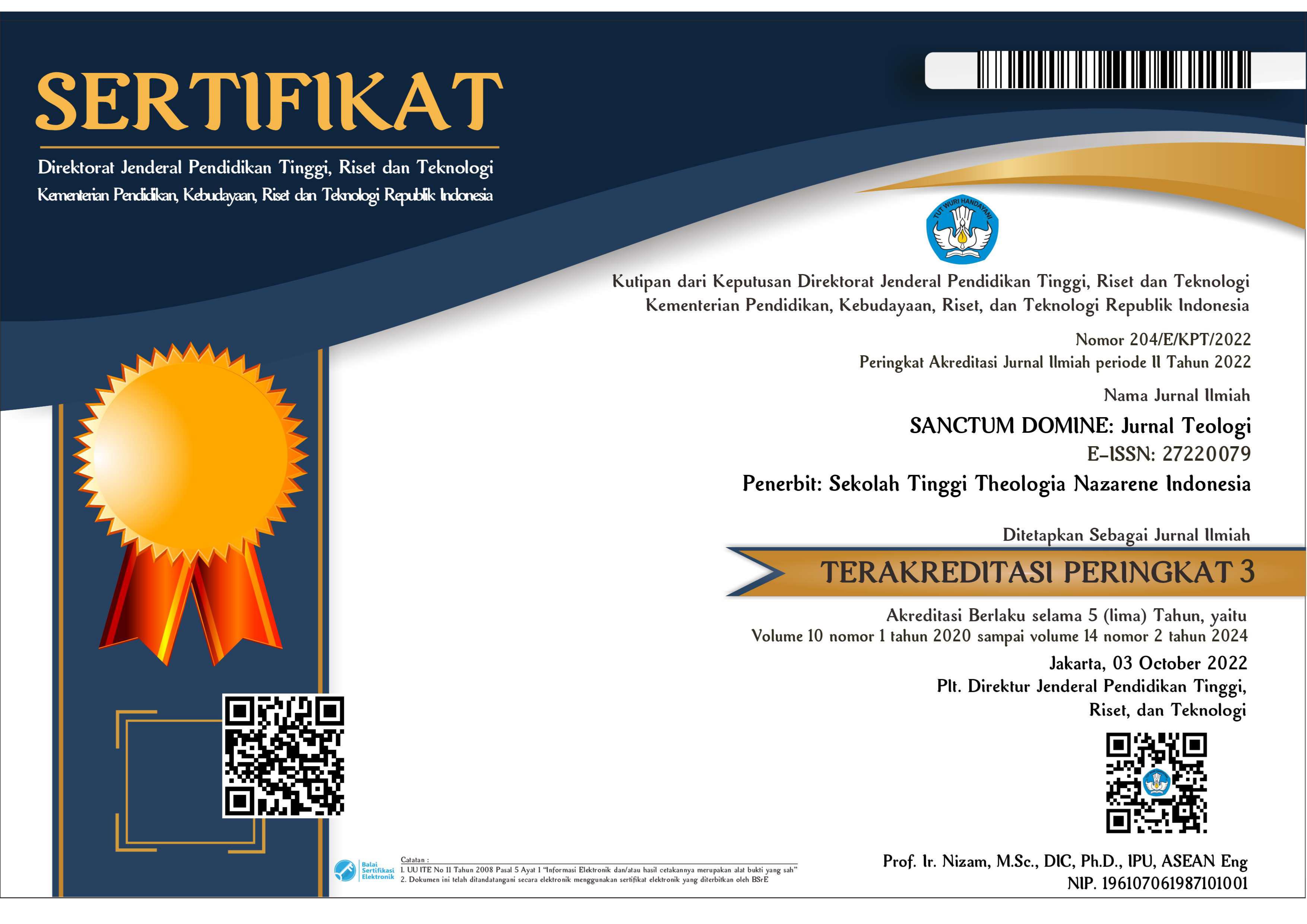Konsep Penebusan Dosa dalam Bilangan 21:4-9 dalam Wujud Budaya Famatö Harimao bagi Masyarakat Nias
Abstract
The concept and teachings of redemption become a major desire for every religious person, including Christians. Through the teaching of atonement, every people are made aware that God works to liberate sinful humans through His acts of love. This work of God's liberation is understood as a form of human release from the power of sin so this teaching about redemption becomes the basic core of every religious teaching. One of the redeeming teachings of the Bible is found in the narrative of the bronze serpent statue in Numbers 21:4-9. However, it is not the only religion that talks about the teachings of redemption, every culture also has the teachings of redemption, including in this case the culture in the Nias community called Famatö Harimao. By using qualitative methods, especially library research and textual interpretation approaches, this research shows that the narrative of the copper snake statue can be used as the basis for contextualizing Famatö Harimao culture. The results of the study show that the Famatö Harimao culture which has been contextualized through the basis of Numbers 21:4-9 can still be lived and lived by the people of Nias because through this culture the people of Nias have a concept of redemption that is culturally and biblically accountable.
References
Adam, Clarke. “Komentar Tentang Bilangan 21:6.” https://www.sabda.net/modul/Clarke.
Dachi, Yosafat F. Masyarakat Nias Dan Kebudayaannya. Pemerintah Kabupaten Nias selatan: Cetakan 1, 2012.
Dennis, Olson. The Book of Exodus in A Theological Biblical Commentary. Westminster: John Knox Press, 2010.
Duha, Waris. Famadaya Saembu Dan Harimao Di Nias Selatan. Medan: Makalah Seminar Nasional Kebudayaan Nias 1, 1996.
Gill, Jhon. “Komentar Tentang Bilangan 21:7"."Eksposisi Gill Dari Seluruh Alkitab".” Last modified 1999. https://www.studylight.org/commentaries/geb/number-21.html,1999.
Green, Denis. Pembimbing Pada Pengenalan Perjanjian Lama. Malang: Gandum Mas. Malang: Gandum Mas, 1984.
Harefa, Amstrong. “Eksistensi ”Fondrakõ” Dalam Hukum Adat Nias.” Angewandte Chemie International Edition, 6(11), 951–952. (2018): 10–27.
Harita, Antonius. “Famadaya Harimao Dalam Kehidupan Masyarakat Menamolo Kabupaten Nias Selatan Kepulauan Nias (Kajian Sejarah Seni),” 2014.
Hurowitz, Victor Avigdor. “HEALING AND HISSING SNAKES – LISTENING TO NUMBERS 21:4-9.” Scriptura 87, no. 0 (2013).
Jaya Ndruru, Steven Anugerah, and Firman Panjaitan. “Korelasi Konsep Sunat Dalam Perjanjian Lama Dengan Budaya Sunat Di Masyarakat Nias.” Jurnal Misioner 1, no. 2 (2021): 140–160.
LAI. Alitab Edisi Studi. Jakarta: Lembaga Alkitab Indonesia, 2015.
Nisabella, Qorry. “Respon Atas Gugatan Terhadap Keadilan Allah Dalam Kematian Substitusi Penal Yesus Kristus:Suatu Kajian Berdasarkan Pada Teori Pendamaian Jhon Calvin.” Sekolah Tinggi Teologi Amanat Agung, 2017.
Panjaitan, Firman. “Membangun Teologi Pertanian Melalui Pembacaan Lintas Tekstual Injil Matius Dan Kosmologi Jawa.” BONAFIDE: Jurnal Teologi dan Pendidikan Kristen 1, no. 1 (2020): 44–64.
Panjaitan, Firman, and Hendro H. Siburian. “Misi Kristologi Dalam Konteks Kebudayaan.” Logia: Jurnal Teologi Pentakosta 1, no. 1 (2019): 42–59.
Prabowo, Prabowo. “Problematika Nomos Dan Hubungannya Dengan Kasih Karunia Dalam Surat Roma.” Journal KERUSSO 5, no. 2 (2020): 75–93.
Purnomo, Albertus. Wacana Biblika Perjalanan Di Padang Gurun Dalam Kitab Bilangan. Jakarta Selatan: Lembaga Alkitab Indonesia, 2021.
Reksosoesilo, Budimoeljono. “Kutukan Yahwe Dan Spiritual Warfare Serta Dampaknya Bagi Pertumbuhan Gereja.” Veritas: Jurnal Teologi dan Pelayanan 5, no. 2 (2004): 225–243.
Seters, John Van. “The Pentateuch.” England: Sheffield Academic Press, 1999.
Setiawan, David Eko. “Menjembatani Injil Dan Kebudayaan Dalam Misi Melalui Metode Kontekstualisasi.” FIDEI: Jurnal Teologi Sistematika dan Praktika 3, no. 2 (2020): 160–180.
Sitorus, Gideon Hasiholan. “Pemilihan Dan Perjanjian Bangsa Israel Sebagai Hamba Tuhan (Tinjauan Teologis – Diakronis Kitab Deutro Yesaya Dan Implementasinya Untuk Kehidupan Kristen Saat Ini).” Areopagus : Jurnal Pendidikan Dan Teologi Kristen 19, no. 1 (2021): 152–164.
Strootman, Rolf. “The Serpent Column: The Persistent Meanings of a Pagan Relic in Christian and Islamic Constantinople.” Material Religion 10, no. 4 (2014): 432–451.
Suzuki, Peter. The Religious System and Culture of Nias-Indonesia. Graventage: Vitgeverij, 1959.
Sylenthini, P. R., and S. R. Pholtan Rajeev. “Snake (Serpents) In the Holy Bible.” IOSR Journal of Environmental Science, Toxicology and Food Technology (IOSR-JESTFT) 5, no. 1 (2020): 49–55.
Thomas, DD. “‘Komentar Pada Bilangan 21:6’."catatan Ekspositori Dr.Constable".” Studylight. Last modified 2012. https://www.studylight.org/commentaries/dcc/number-21.html.2021.
Waoma, Demetrius. “The Translation Ideology Of Nias Cultural Terminology In Famatö Harimao Into Bahasa Indonesia Ritus Patung Harimau.” Tesis. University of Sumatera Utara, 2013.
Wau, Waspada. “Fanaruyama.” Makalah Seminar Internasional: potensi pemuda,Prospek dan tantangan masa depan (2012): 11.
Zai, Iman Nuel, and Thuan Ong. “Memahami Konsep Penebusan Dalam Hukum Taurat Dan Penggenapannya Dalam Diri Yesus Kristus.” Jurnal Teologi Pondok Daud.
Zaluchu, Sonny Eli. “Perspektif Antropologi Dan Religi Perkawinan Suku Nias.” Sejarah dan Budaya: Jurnal Sejarah, Budaya, dan Pengajarannya 14, no. 2 (2020): 108.
Copyright (c) 2022 SANCTUM DOMINE: JURNAL TEOLOGI

This work is licensed under a Creative Commons Attribution-NonCommercial-ShareAlike 4.0 International License.
This is an open-access article distributed under the terms of the Creative Commons Attribution-NonCommercial-ShareAlike 4.0 International License (http://creativecommons.org/licenses/by-nc-sa/4.0/) which permits unrestricted non-commercial used, distribution and reproduction in any medium

This work is licensed under a Creative Commons Attribution-NonCommercial-ShareAlike 4.0 International License.



8.png)









